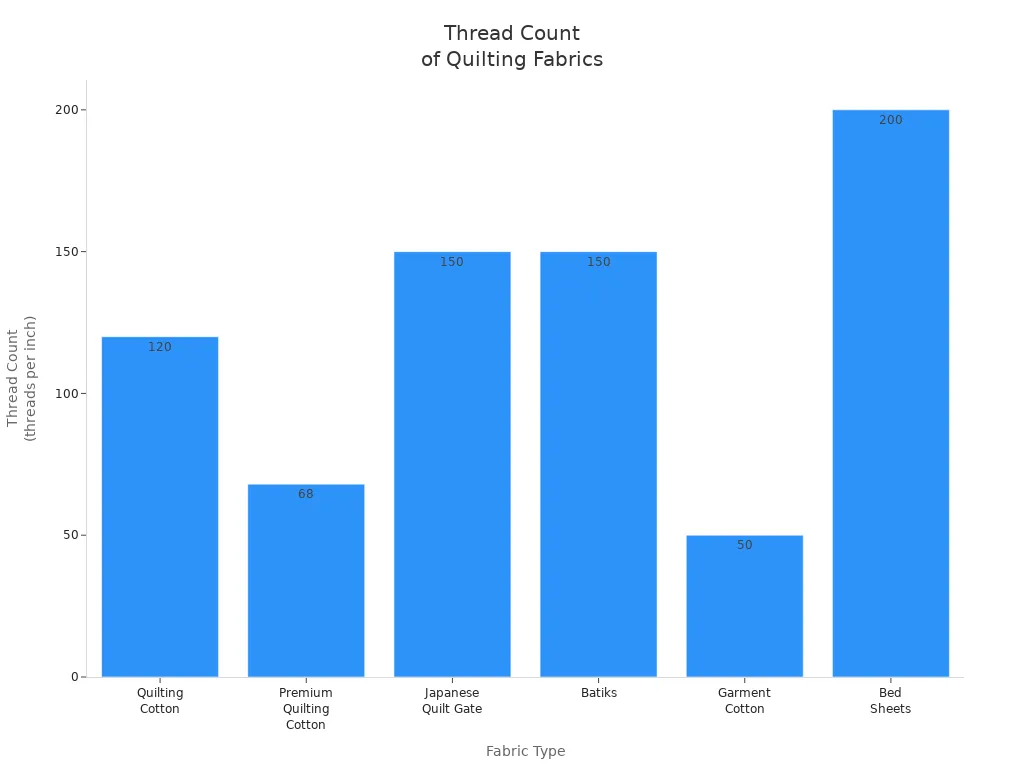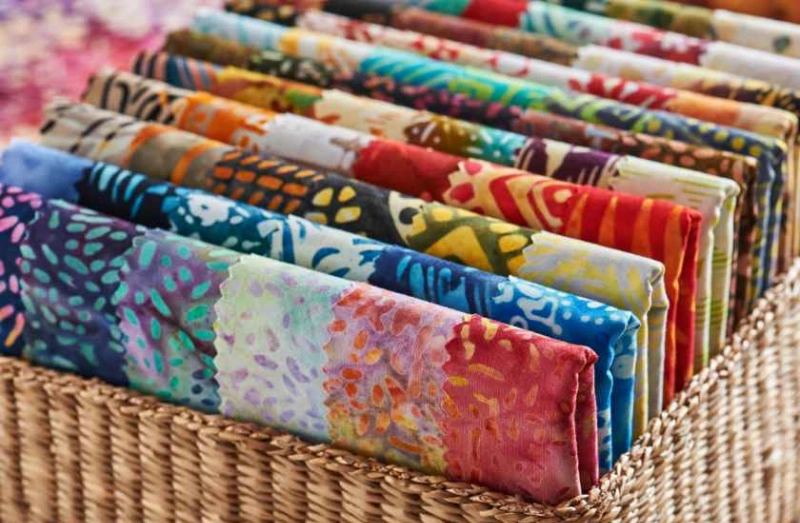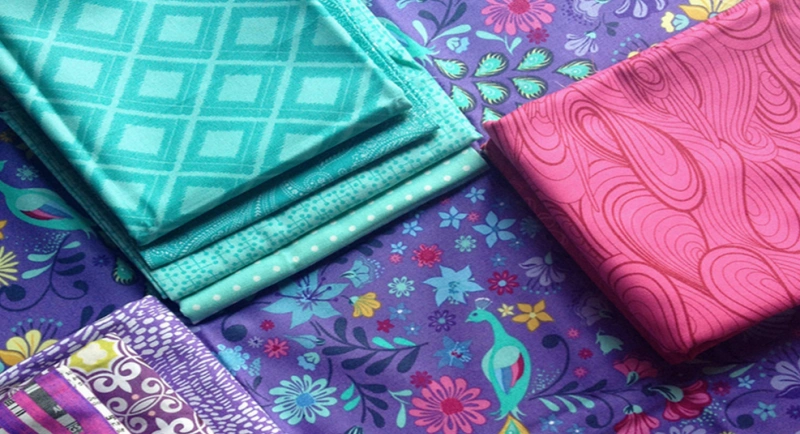If you want your patchwork quilt to last, quilting cotton is the best fabric for patchwork quilts. Quilting cotton feels soft, sews smoothly, and holds up well over time. You’ll find that most quilters agree—100% cotton delivers the comfort, durability, and vibrant colors you need.
With the quilting market growing to over $5 billion in North America, you’re in good company when you look for high-quality fabric. Fanda Fabrics offers a wide selection of quilting cotton, so you can confidently start your next quilt with beautiful, reliable materials.
Key Takeaways
Quilting cotton is the best fabric for patchwork quilts because it is strong, soft, and easy to sew.
Choose medium-weight, tightly woven cotton for durability and smooth sewing.
Pre-wash all fabrics to prevent shrinking and color bleeding before starting your quilt.
Mix fabrics with similar weight and texture to keep your quilt flat and easy to sew.
Fanda Fabrics offers a wide variety of high-quality quilting cotton and custom options to help you create beautiful, lasting quilts.
Best Fabric for Patchwork Quilts
Quilting Cotton Overview
When you start a patchwork quilt, you want a fabric that makes the process smooth and the results beautiful. Quilting cotton stands out as the best fabric for patchwork quilts. You get a material made from 100% cotton fabric, which means strength and breathability.
Quilting cottons have a tight weave and a smooth texture. You can cut, sew, and press them with ease. The higher thread count gives you durability and a crisp surface for precise piecing.
Here’s what makes quilting cotton so popular among quilters:
Made from 100% cotton fabric, offering strength and comfort.
Tight weave and lightweight feel.
Smooth texture for easy handling.
Higher thread count than standard cotton, so your quilt lasts longer.
Wide range of vibrant prints and patterns for creative expression.
Durable and easy to care for, perfect for beginners and experienced quilters.
Affordable, making it accessible for all your quilting projects.
You’ll notice that quilter’s cotton comes in many styles. You can find classic florals, modern geometrics, and specialty prints. Fanda Fabrics’ Quilting Collection gives you access to premium quilting cotton, including precut bundles, bolts, and charm packs.
You can choose from organic cotton muslin, solid colors, and printed designs. Whether you want a traditional look or something bold, you’ll find the best quilting fabric for your next quilt.
Tip: If you want your quilt to last for years, always start with high-quality quilting cotton. You’ll thank yourself later!
Why Quilting Cotton Is Preferred?
You might wonder why quilter’s cotton is the top choice for patchwork quilts. The answer comes down to performance, appearance, and longevity. Quilting cotton has a thread count of at least 60 threads per square inch, which makes it denser and more durable than garment cotton.
This density means your quilt will be opaque, strong, and able to withstand years of use.
Here’s a quick look at how quilting cotton compares to other fabrics:
Fabric Type | Typical Thread Count (threads per inch) | Notes |
|---|---|---|
Quilting Cotton | 60 x 60 (120 total) | Standard quilting cotton like Kona Cottons; average range 60-75 threads per inch square |
Premium Quilting Cotton | Around 68+ | Higher quality quilting cottons with denser weave |
Japanese Quilt Gate | About 150 | Higher thread count quilting fabric |
Batiks | 100 to 200 | Slightly higher thread count than typical quilting cotton |
Garment Cotton | Lower than quilting cotton | Lighter, more translucent, less dense, and durable |
Bed Sheets | Around 200 | Higher thread count, but generally used for quilt backings, not quilt tops |

Quilter’s cotton is soft and flexible. You get a forgiving drape, which is great for curved piecing and hand sewing. Your quilt feels cozy and looks classic. If you want a more structured and modern look, you might try poplin, but quilting cotton remains the best fabric for patchwork quilts for most projects.
Expert quilters with decades of experience agree. They say name-brand quilting cotton is superior because it uses higher quality materials, tighter weave, and more finishing processes. You get less stretching, less fraying, and more vibrant colors. Your quilt will stay beautiful for years.
When you shop Fanda Fabrics’ Quilting Collection, you’ll see why so many quilters trust their products. Customers rave about the wide variety, vibrant colors, and soft hand feel.
You can pick classic prints, modern designs, or specialty fabrics. The best quilting fabric is always at your fingertips, and you get excellent customer service every time.
If you want your patchwork quilt to stand out and last, choose quilter’s cotton from Fanda Fabrics. You’ll enjoy every step of the process and love the finished result.
Types of Quilting Fabric
When you start a new quilt, you’ll notice there are many types of quilting fabric to choose from. Each one brings its look, feel, and benefits to your patchwork projects. Let’s break down the most popular options so you can pick the best fit for your next creation.
Cotton
You can’t go wrong with quilter’s cotton. This 100% cotton fabric is the gold standard for patchwork. Quilting cotton has a tight weave and mid-weight feel, making it easy to cut, sew, and press. You’ll find it holds its shape well and comes in a huge range of colors and prints.
Quilter’s cotton is durable, comfortable, and easy to care for. It’s perfect for both beginners and experienced quilters. You’ll love how your quilt looks and feels when you use high-quality quilting cottons.
Tip: Quilter’s cotton is easy to work with and rarely bleeds color if you choose quality brands.
Batik Patchwork Fabric by Fanda Fabrics

If you want something unique, try batiks. Fanda Fabrics’ Batik Patchwork Fabric uses a wax-resist dyeing technique. This process creates vibrant colors and intricate, marbled patterns that stand out in any quilt.
Batik patchwork fabric feels a bit heavier than regular quilting cotton, but it’s still breathable and durable. You’ll notice the texture and colorfastness hold up even after many washes. Batiks add a special touch to your patchwork, making every quilt one-of-a-kind.
Batik patchwork fabric offers:
Distinctive, colorful designs
High durability and color retention
A slightly heavier, textured feel
Bright Quilt Fabric by Fanda Fabrics

Looking to add energy to your quilt? Bright quilt fabric from Fanda Fabrics brings bold, eye-catching colors like neon pinks, electric blues, and sunny yellows. You’ll find playful patterns—florals, polka dots, geometrics—that make your quilt pop.
This fabric is made from soft, high-quality cotton, so it’s easy to sew and comfortable to use. Bright quilt fabric is perfect for modern quilts, kids’ projects, or any time you want your patchwork to stand out. Fanda Fabrics also offers customization, so you can create a truly personal design.
Linen and Other Options
You might want to explore other types of quilting fabric, too. Linen gives your quilt a natural, textured look and feels cool in hot weather. It’s durable and softens over time, but it can wrinkle and costs more than cotton. Flannel fabric is another cozy choice, especially for baby quilts or winter throws.
Flannel is soft and warm, though it has a looser weave and needs pre-washing to prevent shrinkage. Some quilters use wool or synthetic blends for special projects. Each fabric brings its own strengths, so you can mix and match to suit your style.
Here’s a quick table to help you compare the main types of quilting fabric:
Fabric Type | Material Composition | Key Properties & Uses |
|---|---|---|
Quilter’s Cotton | 100% cotton | Durable, holds shape, wide color range, easy to sew |
Batiks | Cotton, wax-resist dyed | Vibrant, unique patterns, tight weave, colorfast |
Flannel Fabric | Cotton, wool, or synthetics | Soft, warm, loose weave, great for cozy quilts |
Linen | Flax fibers | Natural, textured, breathable, elegant, can wrinkle |
Precuts | Various cotton fabrics | Pre-cut packs, coordinated colors, save time |
You have so many types of quilting fabric to explore. Fanda Fabrics makes it easy to find the right material for every quilt, whether you want classic quilter’s cotton, bold batiks, or bright, modern prints.
Best Fabric for Quilting: Key Qualities
Weight and Weave
When you pick fabric for quilting, weight and weave matter a lot. You want a fabric that feels just right—not too heavy, not too flimsy. Quilting weight cotton is the gold standard here. It has a medium weight, usually between 150 and 160 GSM, which gives your quilt structure without making it stiff.
The tight weave keeps the fabric stable, so your pieces line up and your seams stay sharp. If you use fabric that’s too thick, your quilt can feel bulky and hard to sew. If it’s too thin, it might shift around or wear out quickly.
Fanda Fabrics offers quilting weight cotton with a smooth, even weave, making it easy for you to cut, sew, and press.
Tip: Always check the weave and weight before you buy. Medium-weight, tightly woven cotton will give you the best results for most projects.
Durability and Comfort
You want your quilt to last for years and feel cozy every time you use it. That’s why durability and comfort are key. Quilting weight cotton stands up to daily use, washing, and even a little roughhousing from kids or pets.
Industry experts say that fabric density and thread count (between 60 and 80 per square inch) help your quilt resist tearing and abrasion. Comfort matters, too. The right fabric for quilting feels soft against your skin and keeps you warm without overheating.
Scientific studies show that fabric construction affects both durability and comfort, so always choose high-quality materials. Fanda Fabrics tests their fabrics for strength and comfort, so you can trust your quilt will hold up and feel great.
Color and Pattern Variety
The fun part of quilting is picking colors and patterns that show off your style. A wide variety lets you get creative—maybe you want a bold, modern look or a soft, vintage vibe. Color choice sets the mood for your quilt. Warm colors add energy, while cool colors bring calm.
Mixing light, medium, and dark fabrics helps your quilt design pop and keeps it from looking flat. Fanda Fabrics offers a huge range of colors and patterns, so you can experiment and find the perfect match for your vision. When you have lots of options, you can let your creativity shine and make a quilt that’s truly your own.
Practical Tips for Choosing Quilting Fabric
Pre-Washing and Care
Pre-washing your fabric for quilting can save you a lot of trouble later. You want to avoid shrinkage and color bleeding, especially if you’re mixing different types of fabric. Here’s a simple routine to follow:
Wash all your fabrics with similar colors to prevent dye transfer.
Skip fabric softeners—they make cutting and piecing harder.
Wash your fabric as soon as you bring it home.
After washing, lay it out, clip loose threads, and snap the fabric to reduce wrinkles.
Dry on medium heat, but pull it out while still a bit damp.
Iron right away to keep it smooth.
If you’re not using it immediately, fold it and press with starch before cutting.
Use spray starch for extra stiffness and accuracy.
Pre-washing removes chemicals and preshrinks your fabric, so your quilt stays the size you want. For delicate fabrics like linen or batik, hand washing and air drying flat work best.
Always test for colorfastness before washing a finished quilt. Regular care, like gentle vacuuming and spot cleaning, helps your quilt last for years.
Tip: Use color catchers in the wash to catch any stray dye and keep your quilt looking bright!
Mixing Fabrics
Combining fabrics in one quilt lets you get creative, but you need to plan ahead. Choose fabrics with similar weights and drape so your quilt doesn’t end up lumpy or distorted.
Adjust your seam allowances for thicker or thinner fabrics. Layer lighter fabrics on top of heavier ones for smoother stitching. If you’re working with slippery or lightweight fabrics, try using interfacing to add stability.
Prewash everything to avoid shrinkage surprises. Balance your colors and prints—think about how each fabric will look next to the others. Label your pieces to keep track of grain and texture.
Polyester thread works well for mixed-fabric quilts because it’s strong and flexible. If you’re new to mixing, test your fabric selection on a small project first.
Common mistakes include skipping prewashing, working with too much fabric at once, and uneven seams. Cut your fabric into manageable pieces and use a 1/4″ presser foot for consistent seams. Don’t forget to baste well to avoid puckering.
Shopping with Fanda Fabrics
Shopping for fabric for quilting should feel fun, not stressful. Fanda Fabrics makes it easy with a huge variety of colors, patterns, and textures. You can upload your photos or designs to create custom fabric.
Want a special color or finish? Fanda Fabrics lets you match shades, pick textures, and even order custom sizes. Whether you love classic cotton, rustic linen, or something unique, you’ll find it here.
You can order as little as one meter, so you don’t have to buy more than you need. The team updates patterns often, so you always have fresh options for your next quilt. If you want your quilt to stand out, try their customization services for a truly personal touch.
Note: Great fabric selection and customization help you create a quilt that’s as unique as you are!
Conclusion
Choosing the right fabric makes all the difference in your quilt. Quilting cotton gives you durability, comfort, and vibrant colors that last for generations. You get a flexible material that handles well and keeps its shape, even after many washes.
Experienced quilters say the feel and quality of your fabric can change the whole look and process. Fanda Fabrics offers a huge selection, helpful guides, and customization options so you can create something unique.
Enjoy every step of your quilting journey. Let your creativity shine and make each quilt a keepsake you’ll love to share.
FAQ
What is the best fabric for patchwork quilts?
You can’t go wrong with quilting cotton. It’s strong, easy to sew, and comes in tons of colors and patterns. Most quilters pick it for its durability and comfort.
Should I pre-wash my quilting fabric?
Yes, you should pre-wash your fabric. This step helps prevent shrinkage and color bleeding later. You’ll get smoother, more accurate results when you start with clean, pre-shrunk fabric.
Can I mix different types of fabric in one quilt?
You can mix fabrics, but try to use ones with similar weight and texture. This keeps your quilt flat and easy to sew. Always pre-wash everything first to avoid surprises.
Tip: Test a small piece of each fabric together before starting your full quilt!
Where can I find high-quality quilting fabric?
You’ll find a wide range of premium quilting fabrics at Fanda Fabrics. They offer cotton, batik, and bright quilt fabrics, plus custom options. You can order as little as one meter, so it’s easy to get just what you need.
